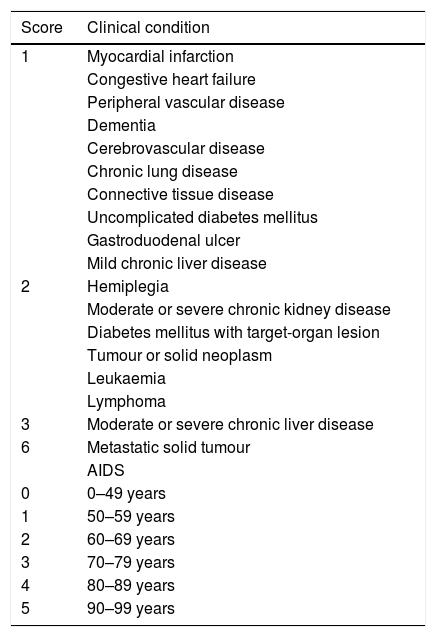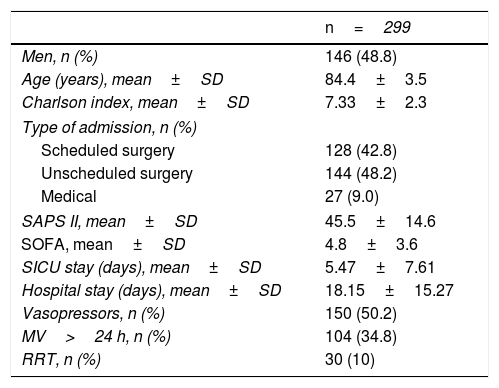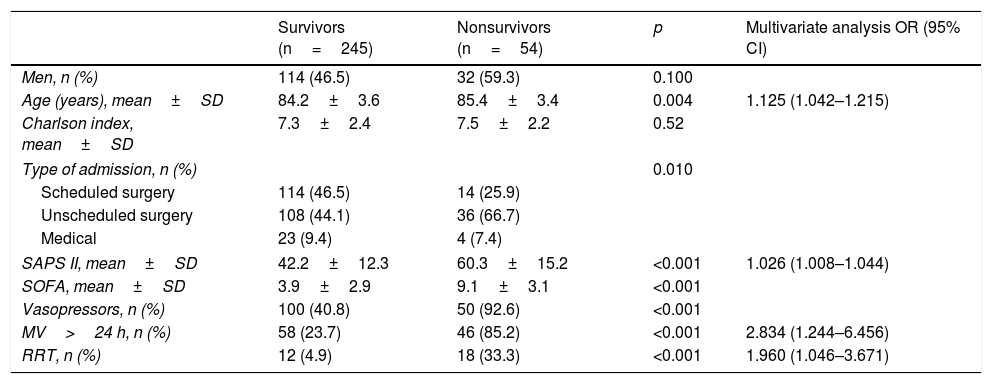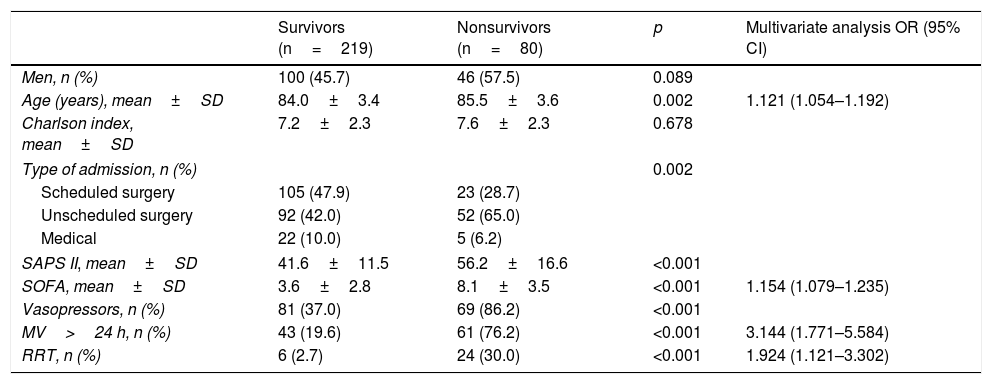To evaluate mortality of patients ≥80 years admitted to the Surgical Intensive Care Unit (SICU), global hospital mortality and factors related to it.
Material and methodsObservational retrospective study of patients ≥80 years admitted to SICU between June 2012 and June 2015.
ResultsA total of 299 patients were included, 54 of them died in the SICU (18.1%) and 80 patients (26.8%) died during their hospital stay. SICU mortality was independently related to age (OR=1.125; 95% CI: 1.042–1.215; p=.003), SAPS II (OR=1.026; 95% CI: 1.008–1.044; p=.004), need for renal replacement therapy (RRT) (OR=1.960; 95% CI: 1.046–3.671; p=.036) and need for mechanical ventilation for more than 24h (OR=2.834; 95% CI: 1.244–6.456; p=.013). Factors independently related to hospital mortality were age (OR=1.125; 95% CI: 1.054–1.192; p<.001), SOFA score (OR=1.154; 95% CI: 1.079–1.235; p<.001), need for RRT (OR=1.924; 95% CI: 1.121–3.302; p=0.018) and need for mechanical ventilation for more than 24h (OR=3.144; 95% CI: 1.771–5.584; p<.001).
ConclusionsIn critically ill patients over 80 years hospital mortality was independently related to age, SOFA score, RRT need and need for mechanical ventilation for more than 24h. Our results raise important issues about end-of-life care and life-sustaining interventions in elderly, critically ill patients.
Evaluar la mortalidad de los pacientes de edad≥80 años ingresados en la unidad de cuidados intensivos quirúrgica (UCIQ), la mortalidad global hospitalaria y los factores asociados a la misma.
Material y métodosEstudio observacional retrospectivo de los pacientes con edad≥80 años ingresados en UCIQ entre junio de 2012 y junio de 2015.
ResultadosSe incluyeron 299 pacientes, de los cuales 54 fallecieron en la UCIQ (18,1%) y 80 pacientes (26,8%) durante su ingreso hospitalario. La mortalidad en la UCIQ se relacionó de forma independiente con la edad (OR=1,125; IC 95%: 1,042-1,215; p=0,003), SAPS II (OR=1,026; IC 95%: 1,008-1,044; p=0,004), la necesidad de técnicas de reemplazo renal (TRR) (OR=1,960; IC 95%: 1,046-3,671; p=0,036) y la necesidad de ventilación mecánica invasiva más de 24h (OR=2,834; IC 95%: 1,244-6,456; p=0,013). Se relacionaron de forma independiente con la mortalidad hospitalaria la edad (OR=1,125; IC 95%: 1,054-1,192; p<0,001), la escala SOFA (OR=1,154; IC 95%: 1,079-1,235; p<0,001), la necesidad de TRR (OR=1,924; IC 95%: 1,121-3,302; p=0,018) y la necesidad de ventilación mecánica invasiva más de 24horas (OR=3,144; IC 95%: 1,771-5,584; p<0,001).
Conclusionesla mortalidad hospitalaria en pacientes críticos de edad≥80 años se relacionó de forma independiente con la edad, la escala SOFA, la necesidad de TRR y la necesidad de ventilación mecánica invasiva más de 24h. Nuestros hallazgos plantean importantes cuestiones acerca de los cuidados al final de la vida en los pacientes ancianos críticos quirúrgicos y de la utilización de medidas de soporte vital.
Artículo
Comprando el artículo el PDF del mismo podrá ser descargado
Precio 19,34 €
Comprar ahora










